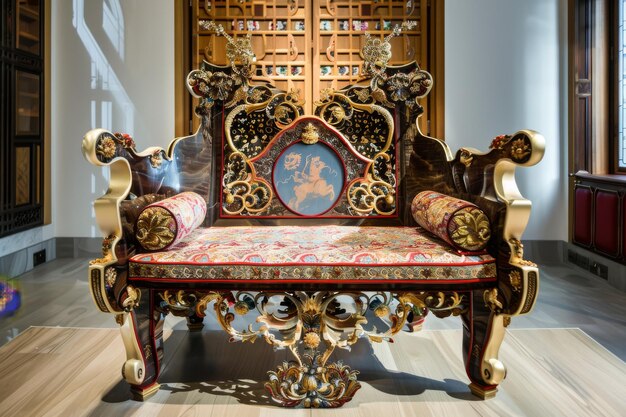Catherine the Great, Empress of Russia from 1762 to 1796, left an indelible mark not only on Russian history but also on art, culture, and luxury design. Renowned for her patronage of the arts, Catherine transformed the Russian imperial palaces into showcases of opulence and elegance. Her appreciation for beauty and sophistication extended to her choice of furniture, which now serves as a testament to her refined taste and the aesthetic trends of 18th-century European aristocracy. Catherine the Great Furniture.
This article will delve into the unique features, influence, and legacy of Catherine the Great’s furniture collection, exploring its stylistic elements, materials, and the artisans who helped bring her vision to life. Catherine’s furniture choices tell the story of a ruler who cherished artistry, power, and the role of cultural refinement in her vast empire.
A Look at Catherine the Great’s Influence on Furniture Design
Catherine the Great’s reign marked a time of significant cultural evolution in Russia. Her fascination with Western European art and architecture translated into a unique style that blended Russian sensibilities with French and Italian influences. She worked closely with architects, artisans, and furniture designers from across Europe to bring this aesthetic to life. Catherine’s commitment to fostering Russian artistry while embracing Western aesthetics is evident in the furniture pieces she commissioned.
Characteristics of Catherine the Great’s Furniture
Furniture from Catherine’s era was defined by its elaborate designs, quality craftsmanship, and luxurious materials. Each piece reflected the grandeur of her court and her desire to create a majestic environment within her palaces.
1. Intricate Detailing and Ornamentation
Catherine’s furniture was adorned with intricate carvings, gilded frames, and detailed embellishments, often featuring floral patterns, cherubs, and mythological scenes. This decorative richness reflected her love for the ornate French Rococo style, which had become popular among European nobility.
2. Use of Rare and Exotic Materials
Only the finest materials were selected for Catherine’s furniture. Exotic woods, such as mahogany and rosewood, were imported for their beauty and durability. These woods were often inlaid with ebony, ivory, and mother-of-pearl, adding a luxurious sheen to each piece.
3. Symbolic Embellishments
Many furniture pieces bore symbols of power and wealth, such as imperial eagles and royal insignias. This iconography served to remind viewers of Catherine’s authority and the prestige of her court. Catherine was known for commissioning furniture that emphasized her unique standing as a ruler and an intellectual.
4. Elegant Upholstery and Fabrics
Catherine’s furniture often featured upholstery made from exquisite fabrics, including velvet, silk, and brocade. The colors and patterns on these textiles complemented the richly adorned woodwork and gilded frames, creating a cohesive look of luxury and comfort.
5. Innovative Functional Design
Beyond its aesthetic value, Catherine’s furniture was often designed with practical functionality in mind. Her furniture pieces included early forms of drawers, compartments, and storage units to accommodate her needs for organized, accessible spaces within her palaces.

The Role of European Artisans in Catherine’s Furniture Collection
To realize her vision, Catherine invited some of Europe’s most talented artisans and craftsmen to Russia. French and Italian artisans, who specialized in Rococo and Neoclassical styles, were commissioned to create pieces that would enhance her residences. They brought with them specialized techniques in marquetry, inlay work, and upholstery. Among the most notable craftsmen were members of the esteemed David Roentgen family, whose German workshop produced furniture for European royalty. The Roentgen craftsmen were celebrated for their mastery of marquetry and mechanical furniture pieces that integrated functional features with lavish design.
Notable Pieces in Catherine the Great’s Furniture Collection
The Amber Room
One of Catherine’s most famous furnishings was the legendary Amber Room, a chamber lined with amber panels and adorned with gold leaf and mirrors. Originally a gift to Peter the Great, Catherine expanded upon the design, turning it into a dazzling display of opulence and craftsmanship. Catherine the Great Furniture.
Catherine’s Throne
Her throne was another symbol of her power and prestige. Crafted from gilded wood and adorned with precious stones, it stood as a centerpiece in the Grand Throne Room, where Catherine received ambassadors and officials. This grandiose chair underscored her position as Empress, blending comfort with imperial grandeur.
Legacy and Influence of Catherine the Great’s Furniture Today
Catherine the Great’s patronage of luxurious furniture set a precedent for Russian nobility, influencing interior design trends well into the 19th century. Her taste for ornate, European-inspired pieces helped establish a standard of opulence that came to define Russian imperial residences. Today, reproductions and influences of Catherine’s furniture can be found in collections and museums worldwide, including the Hermitage Museum in Saint Petersburg. Modern designers frequently draw upon the elegance and splendor of her era, integrating her stylistic elements into contemporary furniture pieces.

Appreciating Catherine the Great’s Furniture Today
Interest in Catherine the Great’s furniture has surged among collectors, historians, and design enthusiasts who admire the luxurious designs and historical significance. Original pieces attributed to Catherine’s collection are now priceless artifacts, housed in museums or private collections. The craftsmanship and materials used have stood the test of time, making these pieces not only works of art but also valuable historical records.
Conclusion: The Lasting Beauty of Catherine the Great’s Furniture
Catherine the Great’s approach to furniture design reflects the cultural synthesis and imperial grandeur that marked her reign. Her appreciation for European art and dedication to the embellishment of her surroundings transformed the palatial interiors of Russia and set an example for generations. Each piece of furniture in Catherine’s collection speaks of her intellect, taste, and vision. The legacy of her patronage endures in the beautifully preserved artifacts that offer a glimpse into the splendor of her court and continue to inspire modern interpretations of classic luxury. Catherine the Great Furniture.










